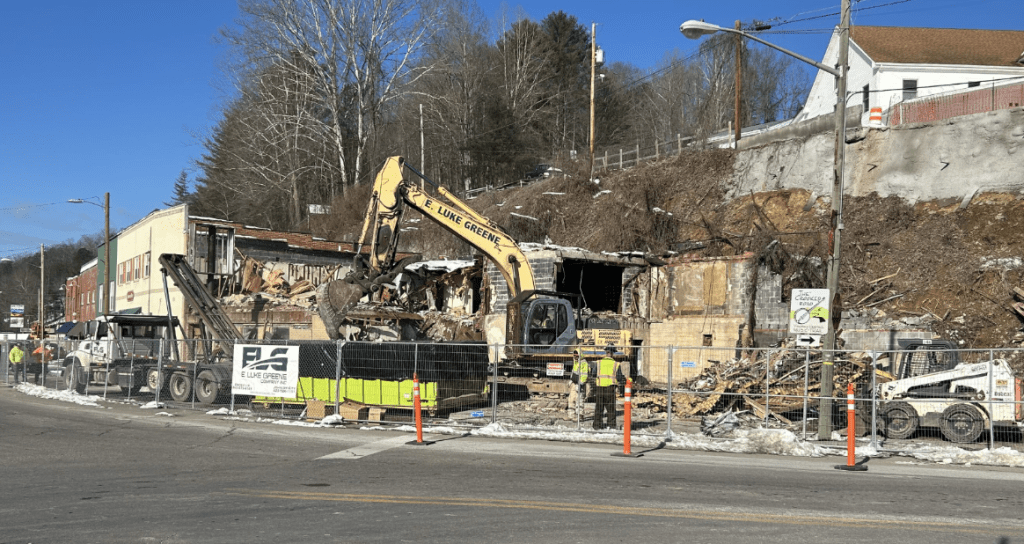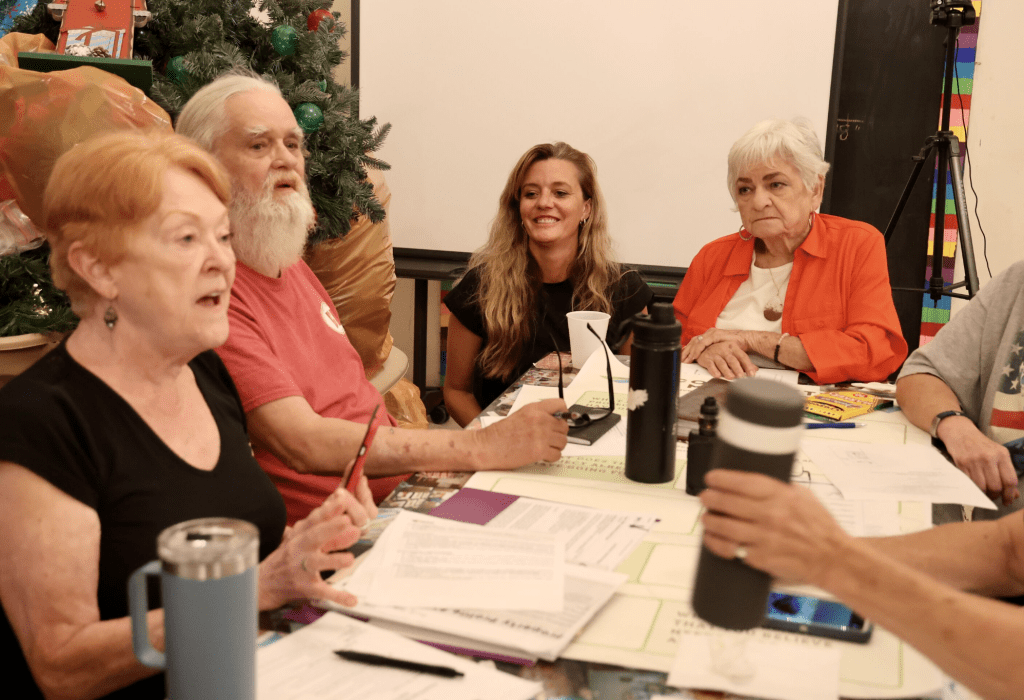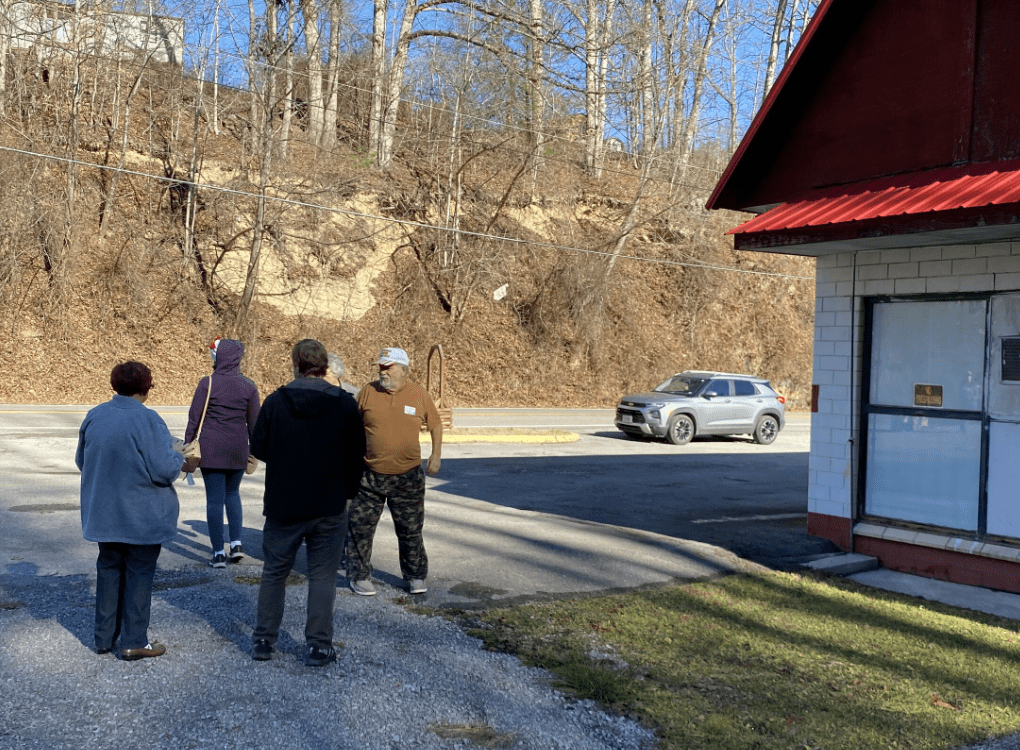Front Porch Blog
On a frigid January morning, with ice and snow from the winter’s heavy storms still covering much of the ground, Hunter Estep of E. Luke Green Construction mans the excavator being used to demolish the old People’s Bank building on the corner of North Main Street downtown in Pound, Virginia. The Scott County, Virginia, native has been hard at work since 7 a.m. and has been making preparations for this day for about two weeks.

Even with preparations, taking down the old bank hasn’t been an easy process.
“This one’s been kind of tedious because of it being connected to another building,” Estep says. “We had to go in at first and make a wall cut in the front and take that part down by hand, brick by brick, and then on the roof, we made an eight-foot separation on the roof so that the shared wall with the existing building is going to stay standing. You see, you’re up there, and you gotta be real easy when you’re tearing down, especially the roof, because if you push on it, it’s going to push that wall over.”
Estep has been working in demolition since he was just out of high school, following in the footsteps of his father, who worked in the demolition field for over 20 years.
“I got the chance to work with Dad, and kind of learned the ropes from him and some of the older guys that used to be here,” he says. “They taught me a lot, man. It’s been good.”
Estep’s work on this project is one of several that has been created through funding initiatives aimed at revitalizing Pound’s historic downtown area to help grow the local economy and prepare for impacts from natural disasters, such as the floods that the town has dealt with in recent years.

Funding from the Environmental Protection Agency’s Environmental Justice Collaborative Problem Solving grant covered a structural engineer for bank building wall assessment and was slated to cover designs for the flood-mitigating riverwalk, in addition to supporting projects in other communities. Unfortunately, as of the time of this writing, the EPA has terminated that grant, citing the Trump administration’s opposition to “diversity, equity, and inclusion” and “environmental justice” initiatives.
However, the broader work continues. The bank building demolition is nearly finished, with the final steps on hold pending approval from the Federal Emergency Management Agency. Town Councilwoman and Vice Mayor Leabern Kennedy says that once the site is secured, the next stage of the project will begin, with plans for the former bank site to become a pocket park featuring a small outdoor stage and local monument to labor as the centerpiece, part of the Monuments Across Appalachian Virginia initiative out of Virginia Tech. The building being taken down was simply unsalvageable for commercial or community purposes as the presence of asbestos combined with a serious mold problem had made it unsafe.
“The building had already started collapsing in on top of itself,” she says. “There were the prettiest little mold spores you’ve probably ever seen in your life. It was like an old man’s gray hair everywhere.”
The bank demolition and pocket park are just one aspect of the Town of Pound’s efforts at revitalizing and building environmental and economic resilience in their downtown area. This builds upon other work that community members, local leaders and area nonprofits and government partners have been conducting in Pound throughout the past year.

Improving Run-down Buildings
Pound has been partnering with the Virginia Department of Environmental Quality as part of the BAD (Brownfields, Abandoned and Dilapidated) Buildings Program, a West Virginia University initiative that helps communities address neglected properties that pose safety, environmental and economic concerns. The program provides technical assistance, resources and strategic planning to support local governments in identifying, assessing and redeveloping abandoned or blighted structures. By revitalizing these properties, the program aims to enhance community aesthetics, stimulate economic development and improve public health and safety.
Last spring, community members gathered to assess and inventory local buildings that fall under the BAD Buildings Program’s guidelines. West Virginia University recently released their final report on the inventory process and prospects for these buildings. The report will be used for future grant applications and to determine which properties could serve as suitable sites for the next project.

Attempting to Prep for the Next Storm
Representatives from the Federal Emergency Management Agency visited Pound in January to discuss partnering as part of the agency’s Building Resilient Infrastructure and Communities Program, a federal initiative that provides funding to states, local governments, tribes and territories to support proactive hazard mitigation projects that strengthen community resilience against natural disasters.
Established under the Disaster Recovery Reform Act of 2018, BRIC prioritizes pre-disaster investments in infrastructure improvements, risk reduction and innovative mitigation efforts to minimize future disaster costs. The program encourages sustainable, nature-based solutions and partnerships to build safer, more resilient communities across the United States.
This partnership was expected to provide Pound with three years of technical assistance to create a resiliency strategy and plan for the BRIC grant application. Community leaders such as Kennedy are also hoping to work with the agency to develop a plan for emergency communications around town.
In February, local leaders were informed that the FEMA BRIC program was paused for 30 days due to the White House’s current efforts to restrict funding. As of recent communications in mid-March, neither Pound nor Appalachian Voices had received further information on the future of this program.
In February of this year, melting snow and ice from an earlier winter storm combined with heavy rains to cause another significant flooding event in parts of Central Appalachia. Pound residents once again found themselves dealing with the aftermath, just as they had in 2022 when major floods hit the region. This latest flood has once again highlighted the need for federal investment in environmental disaster response and mitigation.
Sketching a Future Riverwalk
If you’ve ever driven through Pound, then you’ve seen the Pound River, which winds its way around the downtown area and loops through multiple neighborhoods. Residents have been talking about their wish for a recreational riverwalk to take advantage of this asset for decades.
In order to produce a preliminary design for a Riverwalk based on an initiative in Pound from the early 2000s, Hill Studios, a place-based architecture firm based in Roanoke, conducted a visit to Pound this winter to walk an approximate Riverwalk loop and assess potential obstacles. This project would happen in tandem with sewer work on the Pound River from the Wise County Public Service Authority and would use the opportunity to provide more recreation, walkability, flood mitigation and greenspace to Pound. This initial survey allowed Hill Studios to identify any challenges that might impact the feasibility of the project.
Hill Studios also conducted a listening session to gather feedback about the project from community members. This session provided valuable insights from local residents, helping to shape the design and ensure it aligns with the community’s vision and needs. Locals provided vital feedback involving the community vision, concerns about upkeep, and directions moving forward.
The first draft of the Riverwalk design was presented to the public during the April meeting. This presentationoffered an opportunity for further input and refinement based on community response. Like many communities across the coalfields and the greater Appalachian region, Pound has seen its share of environmental and economic challenges in recent years. But thanks to the grit and determination of the people who call the town home, and no small degree of help from state, federal and private funding sources such as the Monuments Across Appalachian Virginia grant, the town is trying to turn the corner, once again serving as another reminder of why such funding is so vital to coalfield communities.
PREVIOUS
NEXT

Leave a comment
Your email address will not be published. Required fields are marked *

Leave a Comment